Permissionless Collaboration


This is a sequel to "Era of the Onchain Organization," in which we discussed how groups use blockchain networks to work together.
At Splits we talk a lot about onchain teams, specifically — the key demographic for our smart accounts product. These teams often exist within conventional companies (for example, Splits itself). Others take weirder forms like the DAOs and token collectives ("scenecoins") examined in the previous piece. And then some onchain teams are emergent, anarchic, and ephemeral. Admittedly, those ones probably won't use our smart accounts dashboard, but they're fascinating nonetheless.
Today we're examining two interaction systems — creative network structures designed to mutate as they are used. In this paradigm "the artist is seen as a collaborator and a co-producer of the situation (with the audience), and these situations can often have an unclear beginning or end," per the Tate Museum's website.
Burn to build

The artist m/branson has a generative series on Base, aptly titled m/base, which is curated by her audience via burn-to-redeem drops. Every week m/branson releases a new artwork only claimable by burning a previous token from the series. The genesis input token is "we keep breaking things," with a current supply of 626, available on secondary. Burners can also use any subsequent m/base edition before the one that's currently up for grabs.
Usually the new artwork has a maximum possible supply of 7, though there are exceptions. For example, #17 was airdropped to m/branson's Hypersub members, so the supply is 45 (excluding any that were burned since the airdrop). #15 is an available 1/1 that requires burning two input tokens from the collection. In effect, m/branson offers various options to collectors, setting the stage for their decisions.
By consequence, collector interest determines the supply of any given work. When an eye-catching new piece comes along, previous favorites are sacrificed in its favor. Over time only the most highly prized pieces stay in the collection, and the supply of each edition reflects this mechanic. If m/branson continues the series long enough, it is quite possible that some editions will disappear altogether.
Typical assumptions about NFT collections are flipped on their head in an ongoing interrogation of mimesis and artistic value. The rarest editions are not necessarily the prized grails — at least not to start with. Continuing to hold an inadvertent 1/1 that everyone else burned is a powerful statement of conviction in one's own taste.
Conjuring the Zorb

Zorbit is "a large collection of dope generative onchain art that anyone can contribute to but [which] is impossible to own," a complex project on Base conceived and orchestrated by ripe. From a participant's perspective, this is how it works:
- Mint a Zorbit for free directly from the contract (side note, Basescan makes this so easy). There is no limit; mint as many as you want. For example, I minted Zorbit 243.
- The newborn Zorbit is sent to a random Ethereum address. Ahh, but my fingerprint remains upon it: "the pulsing colors are generated based on the minter's and new owner's addresses."
- The randomly selected owner is not entitled to keep the Zorbit: "anyone can initiate a shuffle without permission from the owner and the token will be sent to another random eth address," at which point "the artwork updates to include the new owner and the color generated from that address."
So that's Zorbit — but actually, there's a lot more Zorbit where the first Zorbit came from.
- You can also mint a Zorbit Edition, either on Zora or through zorbit.wtf. This one is not free, but you get to keep it!
- Every Zorbit Edition starts out with identical artwork.
- Next, you can "commit" your Zorbit Edition to help create a Collective Zorb. This does two things:
- A new Zorbit (the kind from the first chunk of bullet points) is created and dispensed to a random Ethereum address.
- The committed Zorbit Edition is earmarked for the next Collective Zorb.
- A Collective Zorb takes four Zorbit Editions. You can contribute all four, but it's more fun to wait for someone else to commit their Zorbit Edition(s) too.
- Once four Zorbit Editions have been committed, a new Collective Zorb comes into being. The artwork of the component Zorbit Editions updates to a shimmering display of colors "pulled from the 4 zorbit tokens minted during the edition commits." This new Collective Zorb artwork is "co-created and co-owned by the edition owners."
- For example, Splits contributed two Zorbit Editions to help create Collective Zorb 36.
- A Collective Zorb is not frozen in time: "when a zorbit token is shuffled to a new owner" — remember, the random ETH address that receives a Zorbit doesn't necessarily get to keep it — "the colors on the zorbit update to reflect the new owner's addr." Because the commit-spawned Zorbits are inputs to the Collective Zorb, it also changes when they do.
Meanwhile, the price of Zorbit Edition increases by 0.0001 ETH whenever a new Collective Zorb is born. This "incentivizes edition holders to participate in the project instead of sitting on blanks, while offsetting supply inflation by slowly increasing the price to mint new tokens as participation grows." In theory, if you mint Zorbit Editions for financial purposes, you also benefit from committing Editions to create Collective Zorbs, which raises the price of a new Edition.
Let's say you mint 500 Zorbit Editions at 0.011277 ETH each (current total cost, including the Zora protocol fee). If you commit 200 of them to create new Collective Zorbs, minting new Zorbit Editions now costs 0.016277, whereas you can sell the Zorbit Editions you already minted for 0.015 ETH each and profit by 0.003723 ETH per Edition. If you successfully sell your 300 remaining Zorbit Editions you make 1.1169 ETH total profit, covering the price of 99 of your original mints. (We're just, uh, ignoring fees for the moment.) The volume needed to actually break even makes this an impractical trade, but it's a cool mechanic.
I have one criticism for ripe: the similar names made this setup really confusing for me to understand. Until I sat down to concentrate on dissecting ripe's explanation, I was under the impression that Zorbit Editions were also sent to random Ethereum addresses. I got a lot more excited once I realized you could keep them! I also didn't realize that Collective Zorbs were "hosted" by the four Zorbit Editions committed to create them; I thought Collective Zorbs were new NFTs altogether.
The whole Zorbit project is an intricate web of incentives that beckons you to cast a spell and make some magic onchain. What exactly will result can only be discovered through the process of conjuring.
Do you have a favorite example of an interaction system like the ones described above? (It doesn’t have to be an NFT project.) Please reply to this email and share! One of the respondents will receive ¼ of a Collective Zorb 🔮